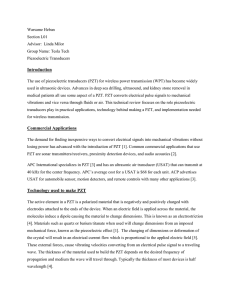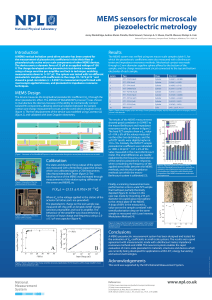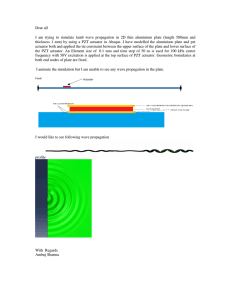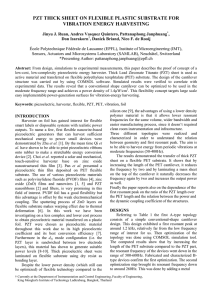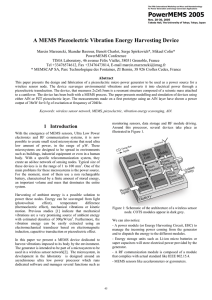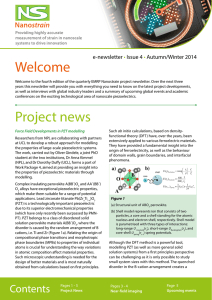STUDY OF THE OPERATION-FREQUENCY BROADENING EFFECT OF MEMS PIEZOELECTRIC ENERGY HARVESTER
advertisement
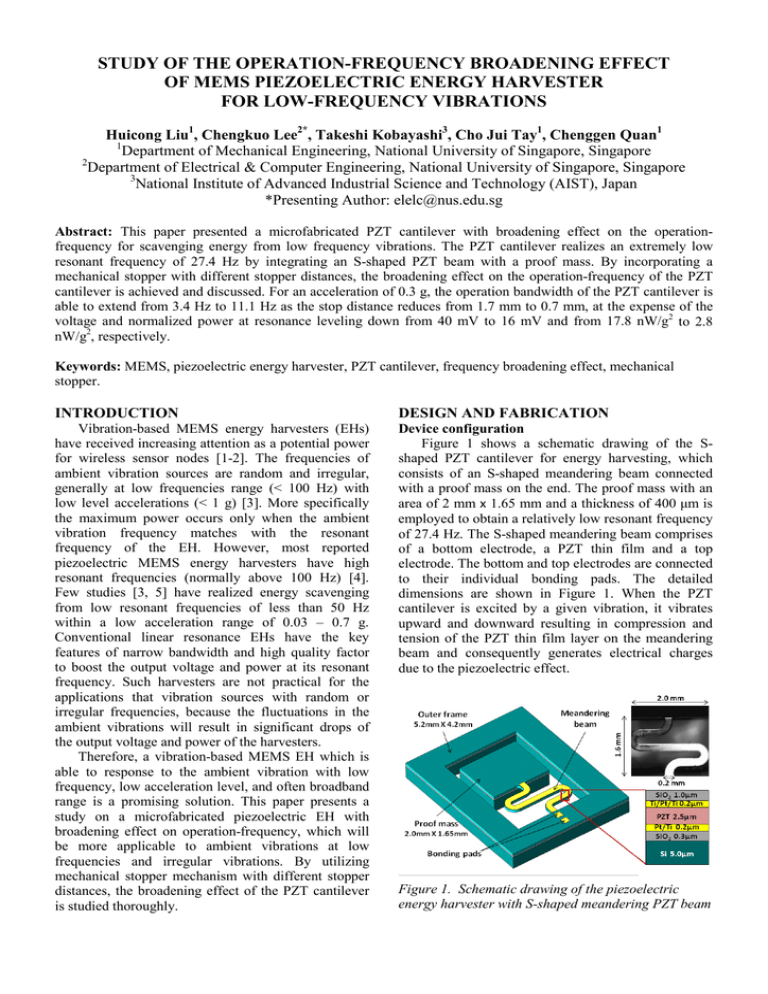
STUDY OF THE OPERATION-FREQUENCY BROADENING EFFECT OF MEMS PIEZOELECTRIC ENERGY HARVESTER FOR LOW-FREQUENCY VIBRATIONS Huicong Liu1, Chengkuo Lee2*, Takeshi Kobayashi3, Cho Jui Tay1, Chenggen Quan1 1 Department of Mechanical Engineering, National University of Singapore, Singapore 2 Department of Electrical & Computer Engineering, National University of Singapore, Singapore 3 National Institute of Advanced Industrial Science and Technology (AIST), Japan *Presenting Author: elelc@nus.edu.sg Abstract: This paper presented a microfabricated PZT cantilever with broadening effect on the operationfrequency for scavenging energy from low frequency vibrations. The PZT cantilever realizes an extremely low resonant frequency of 27.4 Hz by integrating an S-shaped PZT beam with a proof mass. By incorporating a mechanical stopper with different stopper distances, the broadening effect on the operation-frequency of the PZT cantilever is achieved and discussed. For an acceleration of 0.3 g, the operation bandwidth of the PZT cantilever is able to extend from 3.4 Hz to 11.1 Hz as the stop distance reduces from 1.7 mm to 0.7 mm, at the expense of the voltage and normalized power at resonance leveling down from 40 mV to 16 mV and from 17.8 nW/g2 to 2.8 nW/g2, respectively. Keywords: MEMS, piezoelectric energy harvester, PZT cantilever, frequency broadening effect, mechanical stopper. INTRODUCTION DESIGN AND FABRICATION Vibration-based MEMS energy harvesters (EHs) have received increasing attention as a potential power for wireless sensor nodes [1-2]. The frequencies of ambient vibration sources are random and irregular, generally at low frequencies range (< 100 Hz) with low level accelerations (< 1 g) [3]. More specifically the maximum power occurs only when the ambient vibration frequency matches with the resonant frequency of the EH. However, most reported piezoelectric MEMS energy harvesters have high resonant frequencies (normally above 100 Hz) [4]. Few studies [3, 5] have realized energy scavenging from low resonant frequencies of less than 50 Hz within a low acceleration range of 0.03 – 0.7 g. Conventional linear resonance EHs have the key features of narrow bandwidth and high quality factor to boost the output voltage and power at its resonant frequency. Such harvesters are not practical for the applications that vibration sources with random or irregular frequencies, because the fluctuations in the ambient vibrations will result in significant drops of the output voltage and power of the harvesters. Therefore, a vibration-based MEMS EH which is able to response to the ambient vibration with low frequency, low acceleration level, and often broadband range is a promising solution. This paper presents a study on a microfabricated piezoelectric EH with broadening effect on operation-frequency, which will be more applicable to ambient vibrations at low frequencies and irregular vibrations. By utilizing mechanical stopper mechanism with different stopper distances, the broadening effect of the PZT cantilever is studied thoroughly. Device configuration Figure 1 shows a schematic drawing of the Sshaped PZT cantilever for energy harvesting, which consists of an S-shaped meandering beam connected with a proof mass on the end. The proof mass with an area of 2 mm х 1.65 mm and a thickness of 400 μm is employed to obtain a relatively low resonant frequency of 27.4 Hz. The S-shaped meandering beam comprises of a bottom electrode, a PZT thin film and a top electrode. The bottom and top electrodes are connected to their individual bonding pads. The detailed dimensions are shown in Figure 1. When the PZT cantilever is excited by a given vibration, it vibrates upward and downward resulting in compression and tension of the PZT thin film layer on the meandering beam and consequently generates electrical charges due to the piezoelectric effect. Figure 1. Schematic drawing of the piezoelectric energy harvester with S-shaped meandering PZT beam The micro process flow of the PZT cantilever is shown in Figure 2, which starts from a silicon-oninsulator (SOI) wafer with a Si device layer thickness of 5 μm, a buried oxide layer thickness of 1 μm and a Si handle layer of 400μm. In Figure 2 (a), the SOI wafer is oxidized at 1100°C to form a thermal oxide layer thickness of 0.3 μm. After the oxidation, a Pt (0.2 μm)/Ti (0.05 μm) thin film are deposited by DC magnetron sputtering to be used as bottom electrode materials. Followed by sol-gel deposition as reported in our previous study [6], a 2.5 μm thick (100)orientated Pb(Zr 0.52 Ti 0.48 )O 3 film is formed. The (100) crystallographic orientation of PZT is helpful to maximize the dielectric constant and electrical properties of the PZT film [6, 7]. Then a top electrode Pt (0.2 μm)/Ti (0.05 μm) thin film is deposited by DC magnetron sputtering. In Figure 4 (b), the deposited top and bottom electrodes are dry-etched by using Ar ions through mask 1 and 3, respectively. The PZT thin fim is wet-etched by using a mixture of HF, HNO 3 and HCl through mask 2. After that, an insulating oxide layer of 0.8 μm thick is deposited by RF-magnetron sputtering as shown in Figure 4 (c). Contact holes and metal line trenches are opened by reactive ion etching (RIE) with CHF 3 gas through mask 4. Later on, Pt metal lines with Ti adhesion layer are deposited by sputtering and patterned by using Ar ion through mask 5. Finally, in Figure 4 (d), through mask 6, the insulating oxide layer, Si device layer and buried oxide layer are etched by using feed gases of CHF 3 , SF 6 and CHF 3 , respectively. Through mask 7, the Si handle layer and buried oxide layer are etched from the backside by using feed gases of SF 6 and CHF 3 , respectively, to release the PZT cantilever. Figure 3. A packaged PZT cantilever on a dual in-line package (DIP) with top-stopper adjustment mechanism RESULTS AND DISCUSSION Linear oscillator For a low input acceleration of 0.06 g, the vibration amplitudes of the S-shaped PZT cantilever is not sufficient to hit the top and bottom stoppers. As a linear oscillation system, the output voltage v of the load resistor is given by [8] v= − jω c2 d31t p ε y 1 1 2ςωn ωn2 − − ω2 + 2ςωn ω 2 + jω ωn2 (1 + k 2 ) + RC RC p p RC p (5) where ω is the ambient vibration frequency; ω n is the resonant frequency of the PZT cantilever; c 2 is the ratio of the stress in the piezoelectric layer to the vertical displacement of the proof mass; Y is the Young’s modulus of the PZT material, i.e. 72.5 GPa; d 31 is the piezoelectric constant in 31 mode, i.e. -50 pmV-1; ε is the dielectric constant of the PZT material, i.e. 1000 х 8.85e-12 Fm-1; ς is the damping ratio, i.e. 0.006; k is the electromechanical coupling coefficient 2 represented by k 2 = Yd 31 ; C p is the capacitance of the ε Figure 2. Microfabrication processes of the S-shaped piezoelectric energy harvester The microfabricated device as shown in Figure 3 (a) is assembled onto a dual in-line package (DIP) with a spacer in between. For the study of the broadening effect of the PZT cantilever, a top-stopper adjustment mechanism is employed to realize a variable topstopper distance of di as shown in Figure 3 (b). The distance d 0 between the DIP and bottom surface of the proof mass is fixed as 1.7 mm. piezoelectric layer, i.e. 3.2 nF; R is the load resistance value. According to Equation (5), the load voltage is able to be obtained for different vibration frequencies. Figure 4 shows the simulation and experimental results of the output voltages against frequency at input accelerations of 0.06 g. The load resistance is 1 MΩ in the experiments. The experimental result shows a maximum output voltage 42.1 mV which occurs at its resonant frequency of 27.4 Hz. It is seen that the simulation result agrees well with the experimental result. The output voltage and power against load resistance at its resonant frequency of 27.4 Hz and input acceleration of 0.06 g are calculated and shown in Figure 5. As can be seen, under a low input acceleration of 0.06 g, a maximum power of 1.117 nW, which is 0.31 μW/g2 in terms of normalized power, is generated at the optimum load resistance of 1.6 MΩ. the up-sweeping bandwidth of the nonlinear impact oscillation system is broadened as the input acceleration increases from 0.1 g to 0.3 g. Taking the top-stopper distance of d2 as an example, the operation bandwidth increases from 2.6 Hz to 6.0 Hz as the input acceleration increases from 0.1 g to 0.3 g, while the output voltage at resonance remains relatively constant at around 28 mV and the normalized power at resonance decreases from 78.4 nW/g2 to 9.3 nW/g2. For a down-sweeping bandwidth in the case of the nonlinear impact oscillation system, the operation frequency remains similar to that of the system without a stopper. Output rms voltage(mV) 50 Experimental 40 at 0.06 g Simulation 30 20 10 0 10 20 30 Frequency(Hz) 40 Figure 4. Simulation and experimental results of output rms voltages against frequency at input acceleration of 0.06g. 60 1 50 0.8 40 0.6 Power 30 0.4 Voltage 20 Output voltage(V) 1.2 Optimal power (nW) 0 2 3 4 Load resistance(MΩ) Figure 5. Output rms voltage and power against load resistance at resonant frequency of 27.4 Hz and input acceleration of 0.06g Nonlinear impact oscillator When the accelerations above 0.06 g, the vibration behavior of the PZT cantilever changes from a linear oscillation to a piecewise-linear oscillation due to the impact given by the mechanical stoppers [9]. The broadening effect on the operation-frequency of the PZT cantilever is studied and discussed with varying input accelerations of 0.1 g, 0.2 g and 0.3 g as shown in Figure 6. For a specified input acceleration, frequency up-sweeps and down-sweeps are performed with various top-stopper distances of d1 (1.7 mm), d2 (1.2 mm) and d3 (0.5 mm), respectively. It is found that as the top-stopper distance decreases from d1 to d3, the up-sweeping operation bandwidth of the piecewise-linear impact oscillation system is broadened. However, the vibration amplitude is suppressed, and subsequently the output voltage and power are leveled down. For example, at 0.3 g, the output voltage and the normalized power at resonance are decreased from 40 mV to 16 mV and from 17.8 nW/g2 to 2.8 nW/g2 when the top-stopper distance is reduced from d1 to d3. However, the frequency bandwidth is increased from 3.4 Hz to 11.1 Hz, within which the output voltage shows a slightly increasing trend. On the other hand, for a fixed stopper distance, d2_down 20 d3_up d3_down 10 20 30 Frequency(Hz) 40 (b) 50 5 Output voltage(V) 1 d2_up 10 0 0 d1_down 30 0.2 10 0.1g d1_up 40 0 0.2g d1_up 40 d1_down d2_up 30 d2_down d3_up 20 d3_down 10 0 10 20 30 Frequency(Hz) 40 (c) 50 Output voltage(V) Ourput rms voltage (mV) 70 (a) 50 d1_up 40 0.3g d1_down d2_up 30 d2_down d3_up 20 d3_down 10 0 10 20 30 Frequency(Hz) 40 Figure 6. Output rms voltages against frequencies at different accelerations, i.e. 0.1g, 0.2g, 0.3g, and topstopper distances, i.e., 1.7mm, 1.2mm, 0.7mm CONCLUSION From the above discussion, it is seen that a broadening effect of the PZT cantilever can be realized by assembled mechanical stopper mechanism. The broadening effect is strongly influenced by the stopper distance and input acceleration. For a given stopper distance, the operation bandwidth increases with an increment of the input acceleration. Nevertheless, for a given input acceleration, the operation bandwidth increases with a decrement of the stop distance. Meanwhile, a smaller stop distance will also result in a lower output voltage and power. Therefore, there is a trade-off between the operation bandwidth and output power for such nonlinear impact oscillation system. With a comprehensive study of the broadening effect on the operation-frequency of MEMS cantilever-based energy harvesters in this paper, this kind of energy harvester could be a design to scavenge energy from vibration at frequency less than 30Hz. [3] [4] [5] [6] [7] ACKNOWLEDGEMENT This work was partially supported by in research grant of MOE Tier-2 Academic Research Committee (ARC) Fund MOE2009-T2-2-011 (R-263000598112) at the National University of Singapore. REFERENCES [1] Mitcheson P D, Yeatman E M, Rao G K, Holmes A S, Green T C 2008 Energy harvesting from human and machine motion for wireless electronic devices Proc. IEEE 96 1457-1486 [2] Beeby S P, Tudor M J, White N M 2006 Energy harvesting vibration sources for microsystems applications Meas. Sci. Technol. 17 175-195 [8] [9] Miller L M, Halvorsen E, Dong T, Wright P K 2011 Modeling and experimental verification of low-frequency MEMS energy harvesting from ambient vibrations J. Micromech. Microeng. 21 045029 Ralib A A M, Nordin A N, Salleh H 2010 A comparative study on MEMS piezoelectric microgenerators Meas. Sci. Technol. 16 16731681 Liu H, Tay C J, Quan C, Kobayashi T, Lee C 2011 Piezoelectric MEMS energy harvester for low frequency vibrations with wideband operation range and steadily increased output power J. Microelectromech. Syst. (accepted) Kobayashi T, Ichiki M, Tsaur J, Maeda R 2005 Effect of multi-coating process on the orientation and microstructure of lead zirconate titanate (PZT) thin films derived by chemical solution deposition Thin Solid Films 489 74-78 Kobayashi T, Okada H, Masuda T, Maeda R, Itoh T 2010 A digital output piezoelectric accelerometer using a Pb(Zr, Ti)O 3 thin film array electrically connected in series Smart Mater. & Struct. 19 105030 Roundy S, Wright P K 2004 A piezoelectric vibration based generator for wireless electronics Smart Mater. Struct. 13 1131-1142 Soliman M S M, Abdel-Rahman E M, El-Saadany E F, Mansour R R 2008 A wideband vibrationbased energy harvester J. Micromech. Microeng., 18 115021
